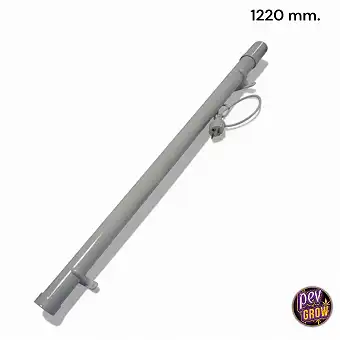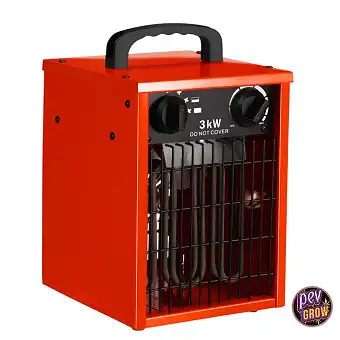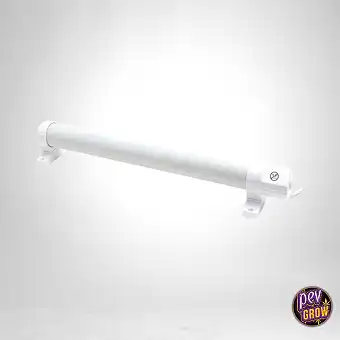Small Electric Heater
Small electric heaters distribute heat quickly and in a controlled manner, stabilizing the indoor temperature and preventing stress on the plants. When well combined with ventilation and humidity management, they improve plant metabolism and reduce the risk of fungi.
This guide helps you choose the right grow heater, calculate power, place it safely, and maintain a tight consumption. Additionally, you will see how to integrate it with climate control professionals and key accessories for consistent performance all year round.
Small Electric Heaters: precise and safe heat for your indoor grow
In an indoor grow, maintaining the temperature within optimal ranges is as important as light and watering. Small electric heaters are perfect allies for compact spaces, grow tents, and small to medium-sized rooms because they offer quick response, fine control through a thermostat, and easy installation. The goal is to achieve a uniform thermal grind —without peaks or stratifications— that favors photosynthesis and avoids dangerous condensations.
Advantages of a small electric heater in indoor
- Quick start: raises the temperature in minutes to avoid “cold nights.”
- Fine control: compatibility with external or integrated thermostats to maintain stable set points.
- Energy efficiency: ceramic formats (PTC) and resistances with low relative consumption, ideal for micro spaces.
- Safety: protection against overheating and IP rating suitable for the environment, reducing electrical risks.
- Compact format: easily integrates with existing ventilation and does not take up growing area.
How to size the power (quick practical rule)
Calculate the volume of the space (m³) and the desired thermal jump (ΔT). For interiors with medium insulation, a guiding value is 25–35 W per m³ to maintain 20–24 °C with moderate ΔT; if the environment is very cold, increase the margin. Remember that airflow and the location of the equipment influence as much as watts: a powerful heater poorly oriented can create “hot spots” without truly heating the canopy.
Safe location and installation
Place the grow heater at a low or medium point, with the output directed towards air corridors and never directly at the plants. Keep distance from cables, plastics, and water; use power strips with protection and electrical lines in good condition. Avoid obstacles in front of the grille to not strangle the flow and, if the equipment includes oscillation, take advantage of it to distribute heat over larger surfaces.
Integration with the Climate Control ecosystem
Heating without renewing the air is a common mistake. Coordinate the heater with extraction and inflow to maintain a balanced microclimate: you renew CO₂, stabilize humidity, and avoid unwanted odors. In cold spikes, use extraction in longer cycles and support recirculation with internal fans to homogenize the temperature between the canopy and substrate.
Relative humidity: when to raise it and when to lower it
Heat reduces relative humidity, and that can be good or bad depending on the phase. In growth, accompany the heater with gentle humidification to not hinder development; in flowering, especially advanced, you may need dehumidification to ward off botrytis. Constantly monitor with a reliable thermohygrometer and adjust according to the target VPD.
Purchase checklist (like a professional)
- Real power and ECO mode: sufficient for your volume, with moderate consumption option.
- Type of heating element: ceramic PTC (quick response and self-regulation) or armored resistance.
- Control: precise thermostat, timer, and compatibility with external controllers.
- Safety: thermal protection, anti-tip, and IP rating suitable for the environment.
- Noise (dB): important if the grow shares space with living areas.
- Air distribution: oscillation and adjustable grilles to avoid cold spots.
Real categories in Pevgrow to complete your system
For a well-rounded climate control, combine your heater with these store complements (each link appears only once):
- Extraction and Ventilation — ducts, silencers, and accessories to move air efficiently.
- Air Extractors — choose flow and pressure suitable for your volume and losses.
- Fans — internal recirculation to homogenize temperature and CO₂.
- Air Humidifiers — raise RH in growth and post-transplant.
- Air Dehumidifiers — lower RH in flowering to prevent molds.
- Thermohygrometers — reliable data to decide with criteria.
- Anti-Odor Carbon Filters — neutralize odors without losing performance.
- Grow Tents — closed structure that facilitates thermal control.
FAQ — Frequently Asked Questions
- How much power do I need for a small grow tent?
- As a guideline, between 200 and 600 W usually covers tents from 60×60 to 100×100 depending on insulation and ambient temperature. Prioritize control by thermostat and verify with thermohygrometer.
- Can I use the heater inside the tent?
- Yes, always with distance from textiles and plastics, avoiding contact with water and without covering grilles. Ensure good recirculation with fans.
- Does the heater increase consumption a lot?
- It depends on the required ΔT and insulation. Models with ECO mode and PTC ceramic adjust power, and a well-configured ventilation reduces on times.
- Better ceramic or resistance?
- The ceramic (PTC) heats quickly and self-regulates, ideal for micro-adjustments; the classic resistance tends to be more economical and robust, suitable for simple spaces.
- How do I avoid mold when heating?
- Control humidity (raise or lower with humidifier / dehumidifier) and renew air with extractors. Maintain an adequate VPD for each phase.
Conclusion
Small electric heaters are an effective, compact, and safe solution to stabilize the temperature of the indoor grow. With proper sizing, a reliable thermostat, and intelligent integration with ventilation, humidity, and filtration, your grow will gain in health, productivity, and consistency. Use the category list to complete the ecosystem and enjoy professional climate control, season after season.
Among all of you who comment or send us your questions there will be a bimonthly draw for a 50 euros voucher to buy in Pevgrow. What are you waiting for? Write now and participate!






